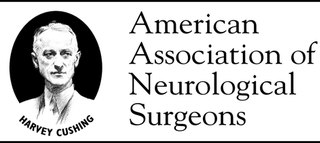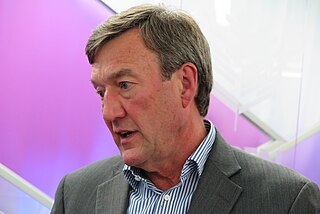
Neurology is the branch of medicine dealing with the diagnosis and treatment of all categories of conditions and disease involving the nervous system, which comprises the brain, the spinal cord and the peripheral nerves. Neurological practice relies heavily on the field of neuroscience, the scientific study of the nervous system.
Osteopathic medicine is a branch of the medical profession in the United States that promotes the practice of science-based medicine, often referred to in this context as allopathic medicine, with a set of philosophy and principles set by its earlier form, osteopathy. Osteopathic physicians (DOs) are graduates of American osteopathic medical colleges and are licensed to practice the full scope of medicine and surgery in all 50 US states. The field is distinct from osteopathic practices offered in nations outside of the U.S., whose practitioners are generally not considered part of core medical staff nor of medicine itself, but rather are alternative medicine practitioners. The other major branch of medicine in the United States is referred to by practitioners of osteopathic medicine as allopathic medicine.
Robert Wartenberg was a clinical neurologist and professor.

Residency or postgraduate training is a stage of graduate medical education. It refers to a qualified physician, veterinarian, dentist, podiatrist (DPM) or pharmacist (PharmD) who practices medicine, veterinary medicine, dentistry, podiatry, or clinical pharmacy, respectively, usually in a hospital or clinic, under the direct or indirect supervision of a senior medical clinician registered in that specialty such as an attending physician or consultant. In many jurisdictions, successful completion of such training is a requirement in order to obtain an unrestricted license to practice medicine, and in particular a license to practice a chosen specialty. In the meantime, they practice "on" the license of their supervising physician. An individual engaged in such training may be referred to as a resident, registrar or trainee depending on the jurisdiction. Residency training may be followed by fellowship or sub-specialty training.

An emergency physician is a physician who works in an emergency department to care for ill patients. The emergency physician specializes in advanced cardiac life support, resuscitation, trauma care such as fractures and soft tissue injuries, and management of other life-threatening situations.

The American Academy of Family Physicians (AAFP) was founded in 1947 to promote and maintain high-quality standards for family medicine, an offshoot of the classical general practitioner. It is headquartered in Leawood, Kansas.
The American Society of Anesthesiologists (ASA) is an educational, research and scientific association of physicians organized to raise the standards of the medical practice of anesthesiology and to improve patient care.
The American Board of Medical Specialties (ABMS) is a non-profit organization established in 1933 which represents 24 broad areas of specialty medicine. ABMS is the largest and most widely recognized physician-led specialty certification organization in the United States. The other certification organizations in the United States are the American Board of Physician Specialties and American Osteopathic Association Bureau of Osteopathic Specialists.

Kenneth M. Heilman is an American behavioral neurologist He is considered one of the fathers of modern-day behavioral neurology.

The American Academy of Osteopathy (AAO) is a non-profit organization for osteopathic medical education. Members include osteopathic physicians and medical students, supporters and affiliates, sponsors, and international members.

The American College of Osteopathic Family Physicians (ACOFP) is a professional association and a medical specialty college in the United States. Its membership consists of osteopathic physicians who practice family medicine, residents and medical students. ACOFP is closely affiliated with the American Osteopathic Association and is the osteopathic equivalent of the American Academy of Family Physicians. Much of the association's activities involve addressing the chronic shortage of family practitioners in the United States. It is responsible for setting the standards for the inspection of osteopathic graduate medical education programs in family practice.

The American Association of Neurological Surgeons (AANS) is a scientific and educational association focused on advancing the specialty of neurological surgery. The organization has over 8,000 members around the world. It is one of the five Continental Associations of the World Federation of Neurosurgical Societies (WFNS), the other four being the AASNS, CAANS, EANS and FLANC.
Orla Hardiman is an Irish consultant neurologist. She was appointed Professor of Neurology by Trinity College University of Dublin in 2014, where she heads the Academic Unit of Neurology, housed in Trinity Biomedical Sciences Institute. She is a HRB Clinician Scientist and Consultant Neurologist at the National Neuroscience Center of Ireland at Beaumont Hospital, Dublin. She leads a team of thirty researchers focusing on clinical and translational aspects of amyotrophic lateral sclerosis and related neurodegenerations. Hardiman has become a prominent advocate for neurological patients in Ireland, and for patients within the Irish health system generally. She is co-founder of the Neurological Alliance of Ireland and Doctors Alliance for Better Public Healthcare. In the past, she established the bi-annual Diaspora Meeting, a forum for Irish neurologists based overseas to present and discuss their research findings with neurologists working in Ireland.
Clinical clerkships encompass a period of medical education in which students – medical, nursing, dental, or otherwise – practice medicine under the supervision of a health practitioner.

Martin A. Samuels, MD, DSc (hon), FAAN, MACP, FRCP, FANA, was an American physician, neurologist and medical educator whose unique teaching style and contributions, accessible to a wide audience, were widely known and celebrated. He wrote and spoke on the relationships between neurology and the rest of medicine, and linked the nervous system with cardiac function, highlighting the mechanisms and prevention of neurogenic cardiac disease.

Aaron A. Cohen-Gadol is a professor of neurological surgery in the department of neurosurgery at Indiana University School of Medicine and a neurosurgeon at Indiana University Health specializing in the surgical treatment of complex brain tumors, vascular malformations, cavernous malformations, etc. He performs removal of brain tumors via minimally invasive endoscopic techniques, which use the nasal pathways instead of opening the skull.
The American Osteopathic Board of Neurology and Psychiatry (AOBNP) is an organization that provides board certification to qualified Doctors of Osteopathic Medicine (D.O.) and physicians who specialize in disorders of the nervous system (neurologists) and to qualified Doctors of Osteopathic Medicine and physicians who specialize in the diagnosis and treatment of mental disorders (psychiatrists).
The Neurocritical Care Society (NCS) is an international, multidisciplinary medical society first established in 2002. The Society is dedicated to improving the care and outcomes of patients with life-threatening neurologic illnesses in the intensive care unit. Common illnesses requiring neurocritical care include ischemic stroke, subarachnoid hemorrhage, intracranial hemorrhage, traumatic brain and spinal cord injury, coma, and status epilepticus. Its members are health professionals providing care to critically ill and injured patients. The Society supports research and education, and advocates on issues related to neurointensive care, neurocritical care, and general critical care.

John Harnett Noseworthy is an American neurologist who served as the president and chief executive officer of Mayo Clinic from 2009 to 2018. A board-certified neurologist specializing in multiple sclerosis, Noseworthy is the former editor-in-chief of Neurology, the official journal of the American Academy of Neurology. Noseworthy has advised the administration of President Donald Trump on health care issues. He has advocated for research funding and telemedicine as a means to reduce the costs of treating patients, among other things. Under Noseworthy's leadership, Mayo Clinic and governments in Minnesota launched the Destination Medical Center (DMC) initiative to advance Minnesota as a global destination for health care and wellness. Prior to his appointment as CEO of Mayo Clinic, Noseworthy held several leadership roles within the organization.

David Hillel Gutmann is an American neurologist-neuroscientist. He teaches at Washington University in St. Louis, where he is the Donald O. Schnuck Family Professor, and Director of the Washington University Neurofibromatosis Center. He is an international expert in Neurofibromatosis, pioneering the use of preclinical models to understand brain tumors and neurodevelopmental delays in children with NF1.












